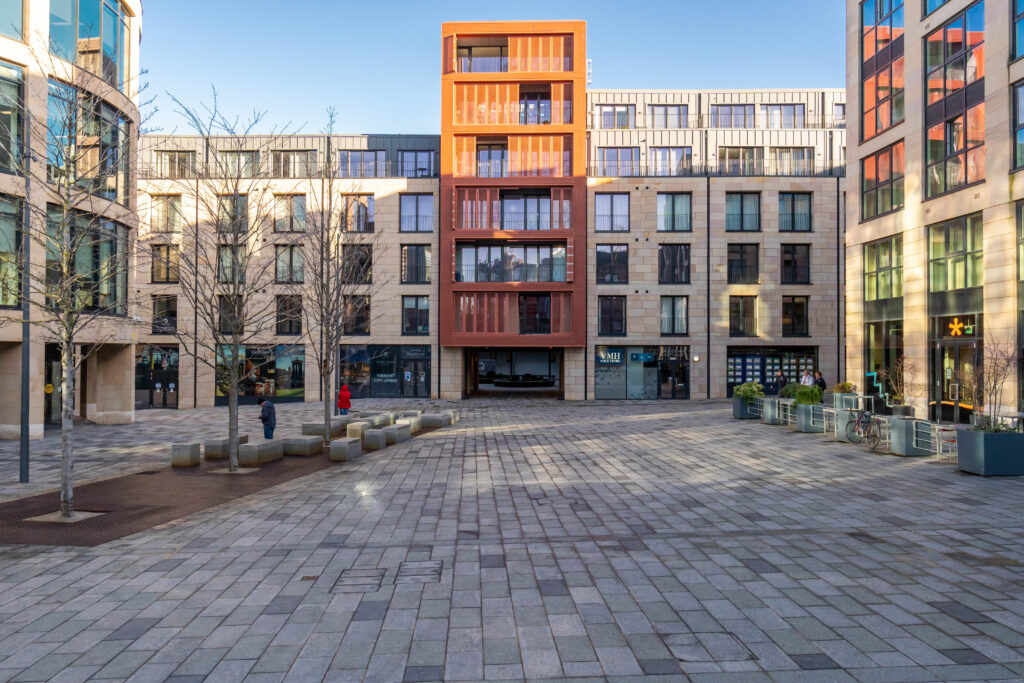New Towns transformed Scotland’s landscape, and their influence on modern architecture is undimming. In this latest article in our Insight series of in-depth analyses of all-things property, Queensberry Properties’ sales and marketing director, Hazel Davies, examines how Scotland’s new towns evolved.
“Scotland is blessed with a unique and rich architectural heritage, but many of its residents live in population centres no older than their parents. While cities tend to evolve organically, New Towns are created from scratch. There are five such towns across our central belt, conceived in a time of great hardship and intended to showcase a better way of life following the collective trauma of two world wars”.
Something old, something New
“If anyone was hoping Edinburgh’s New Town might provide inspiration for Scotland’s post-war conurbations, they’d be disappointed. Georgian Edinburgh’s poverty had inspired a mirror-image grid-pattern layout populated with individually designed townhouses, whereas the 20th century New Towns would be models of centralised planning and repetition. Every detail was sketched out and mocked up in advance, from access roads and town centre amenities to the satellite estates with their homogenous house styles clustered around compact shopping precincts. Certain house designs were replicated across all five conurbations, often facing onto tarmac parking squares and newly planted trees.
“New Towns were a pressing priority for several reasons. Scotland’s biggest cities featured dreadful overcrowding and deprivation, with Glasgow’s Gorbals district housing 90,000 people in squalid and cramped tenements. The Luftwaffe had destroyed most of Clydebank’s 12,000 homes, and it was widely felt that a nation recovering from two wars in thirty years deserved adequate housing. Alongside comprehensive redevelopment of urban districts, thousands of city dwellers would be decanted ten miles away to existing villages, which would be hugely expanded and redesignated as New Towns”.
First among sequels
“Soon after the passing of the 1946 New Towns Act, work began in East Kilbride. It went on to become the biggest and most successful of the five projects, with high levels of resident satisfaction and generous public realm. It celebrated the burgeoning adoption of motor vehicles with dual carriageways and generous parking outside its Americanised indoor mall – a welcome feature on this windswept plateau. Yet other design components remained more traditional, with three-storey blocks of bay-windowed flats abutting grid-pattern terraced houses in the early phases.
“Subsequent New Towns were less imaginative and more driven by value engineering. Cumbernauld was built at a density three times that of East Kilbride, despite occupying a smaller footprint and a less practical hillside location. Cumbernauld reflected the 1960s obsession with concrete, from its over-engineered Brutalist town centre to its system-built tower blocks. By contrast, Livingston and Irvine heralded a partial return to the initial intentions of New Town planners. Cumbernauld’s baffling roads and lopsided sprawl were banished in favour of grid-pattern streets and clearly defined low-rise districts surrounding a (literal and metaphorical) centre, most notably in Glenrothes”.
The New Town that wasn’t
“The Lanarkshire village of Stonehouse was originally designated as Scotland’s sixth New Town in a 1963 Government white paper. East Kilbride Development Corporation drew up ambitions plans for 22,000 new homes, four employment parks and the reinstatement of the train line closed in the Beeching cuts a decade earlier. However, Strathclyde Regional Council began to focus on tackling urban regeneration in Glasgow, minimising the brain drain of young professionals to satellite towns. Two days after the first families moved into brand new homes in Stonehouse, the plug was pulled, despite the government having already spent £4 million of public money. Today, a half-finished bypass and a single cul-de-sac of characterful tree-lined terraced villas provide the only evidence of what might have been.
“Nonetheless, New Town principles continue to influence residential developments. East Kilbride has replaced Paisley as Scotland’s largest town, with its south-western new-build estates mirroring the layout and spacing of older adjacent suburbs. Despite environmental pushback, new districts are still car-oriented in a way pre-war developments rarely were. The concept of the 15-minute city was first encapsulated in local shopping centres at St Leonards, Craigshill and Glenwood. And no large-scale development would be passed by planners nowadays without generous green space provision. Their title might seem increasingly inappropriate, but Scotland’s New Towns continue to influence more modern developments and districts throughout the central belt”.

